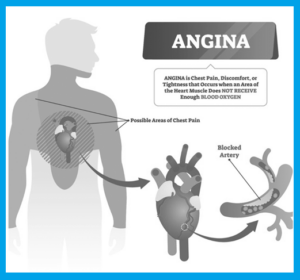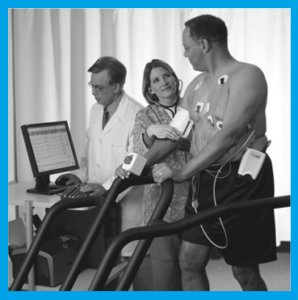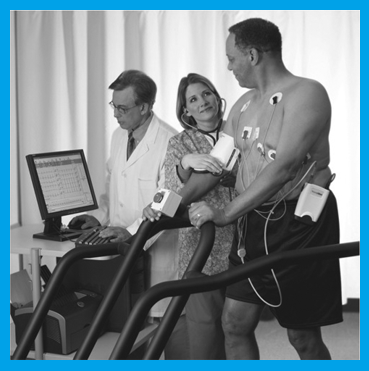Most patients are free of major symptoms after a heart attack, but some complaints are quite common:
Angina
Angina is a discomfort in the chest due to insufficient blood reaching the heart muscle. It is situated mainly in the center of the chest but may be felt on either side of it or in the arms and jaw. It is usually a tight or heavy feeling that is provoked by exercise or emotion but can occur at rest. Many heart attack patients have experienced this previously and they are more likely to have it again than those who have never had it before. Angina is evidence that there is still a narrowed artery supplying blood to the heart muscle. It can usually be treated with medicines, but it may sometimes be
usually a tight or heavy feeling that is provoked by exercise or emotion but can occur at rest. Many heart attack patients have experienced this previously and they are more likely to have it again than those who have never had it before. Angina is evidence that there is still a narrowed artery supplying blood to the heart muscle. It can usually be treated with medicines, but it may sometimes be
necessary to resort to angioplasty or coronary surgery.
Breathlessness
Shortness of breath is quite common during the recovery period after a heart attack. Most often this is due to being out of condition. If this is the case, with a slowly progressive exercise program it will gradually get better. If it does not improve the breathlessness may be caused by the poor pumping action of the damaged heart (“heart failure”). This requires treatment with drugs, such as diuretics, digitalis, or the so-called ACE inhibitors.
Tiredness and Fatigue
These symptoms are very common after a heart attack, but they are more likely to be due to being out of condition or to psychological problems (anxiety or depression) than to the heart itself. They may also be due to drug treatment – especially beta-blockers.
Palpitation
Patients may become uncomfortably aware of the action of the heart, particularly when they are lying on their left side in bed. Occasional thumps or dropped beats can be alarming – sometimes it feels as if the heart has stopped for a few seconds – but they are harmless. On the other hand, prolonged attacks of racing of the heart require medical treatment.
Faintness and Fainting
People who have been in bed for a while often feel faint when they first stand up particularly if they are very warm, as after a hot bath. The circulation has got out of condition and there is a danger of fainting if one does not sit or lie down promptly. Sudden loss of consciousness under other circumstances (especially when the subject is already lying or sitting) needs to be taken seriously after a heart attack and may require investigations into the rhythm of the heart. It can sometimes be due to such drugs as glyceryl trinitrate, beta-blockers, and ACE inhibitors.
What drugs may be used?
Drugs may be used for two different reasons – either to relieve symptoms or to prevent a further heart attack. Details about individual drugs are available from the British Heart Foundation booklet “Medicines for the Heart”.
Drugs that are used for the treatment of angina include nitrates (especially glyceryl trinitrate), beta-blockers, and calcium antagonists. Drugs to treat breathlessness include diuretics, digitalis (digoxin), and ACE (angiotensin-converting enzyme) inhibitors. Drugs to prevent further heart attacks include aspirin, beta-blockers, and anticoagulants.
Tests that may be undertaken
Various tests may be carried out in the convalescent period after a heart attack, to allow the doctors to evaluate its severity so that they can decide what the outlook is likely to be, the amount of exercise that may be permitted, and what further treatment might be needed. Tests are described as “non-invasive” if they do not involve the introduction of tubes (catheters) into the blood vessels and are, therefore, virtually free of any discomfort or risk. These tests include electrocardiography, echocardiography, and nuclear imaging.
Electrocardiogram (ECG)
This record of the electrical activity of the heart is essential for the diagnosis of a heart attack but is also useful in assessing recovery, although it tells us little about the amount of damage that the heart muscle has suffered.
Exercise Electrocardiogram
Exercise often brings out new abnormalities in the ECG that are not seen at rest. Those who have made an excellent recovery can undertake a gentle test lasting 8-10 minutes on a treadmill or stationary bicycle one week or so after the heart attack and get no further changes on the ECG. Those who still have problems with a narrowed artery may develop angina or ECG abnormalities; this
stationary bicycle one week or so after the heart attack and get no further changes on the ECG. Those who still have problems with a narrowed artery may develop angina or ECG abnormalities; this
suggests that treatment for this is required and may indicate the need for further tests. Patients who are too unwell to have an exercise test even one month after the attack will almost certainly require medical or surgical treatment to improve the function of the heart.
Ambulatory (“Holter”) Monitoring
This technique involves the use of a small portable tape recorder (rather like a Walkman) which is attached to electrodes affixed to the chest. These are left in place for 24 hours and record the rhythm of the heart throughout that time. Subsequently, the tape is removed and analyzed. It is mainly used for those who have palpitation or who have evidence suggestive of heart rhythm
disturbance.
Chest X-Ray
At least one chest X-ray is usually taken during the convalescent period to check on the size of the heart and that there is no congestion of the lungs.
Echocardiography
This involves an ultrasound beam which can be used to image the various structures of the heart and their movements. It can help show the severity of the heart attack but is not necessary in all cases.
Nuclear Imaging
A gamma camera is used to detect radioactivity in the heart after the injection of a very small and harmless dose of a radioactive isotope. Depending upon the technique used, this allows evaluation of the pumping activity of the heart muscle or an assessment of whether areas of the heart are deficient in blood supply due to narrowed arteries.
Invasive Tests and Treatments
Cardiac Catheterisation
Involves the introduction of a narrow tube (catheter) into a blood vessel to investigate the condition of the heart and coronary arteries. The test most likely to be carried out after a heart attack is a coronary angiogram, in which a small catheter is inserted under a local anesthetic into an artery in the arm or groin. The tip of the catheter is advanced under X-ray control into each of the coronary arteries in turn, which are made visible by the injection of a substance opaque to X-rays. Coronary angiography is not carried out as a routine after a heart attack. It is usually undertaken only if
angina is proving troublesome or if there are other reasons for thinking that further treatment by angioplasty or surgery is necessary. If tests show that one or more coronary arteries is severely narrowed and that medical treatment is not likely to be successful, two procedures may be considered.
Angioplasty
A special catheter with a small inflatable balloon at the tip is passed into the narrowed artery; the balloon is inflated at the point of narrowing and widens the vessel so that blood can flow down it more easily when the balloon is removed. This is most likely to be used after a heart attack if there is persistent angina. It is particularly suitable if only one of the three coronary arteries is involved.
Coronary Artery Bypass Surgery
This operation is used to provide an alternative route for blood flow to an artery when this is partially or completely blocked. A segment of the vein from the leg or one of the arteries on the inside of the chest wall is used to make a connection between the aorta (the main blood vessel) and the artery beyond the area of narrowing. After a heart attack, it is usually only undertaken if angina fails to respond to medical treatment and angioplasty is not suitable.
Rehabilitation Programme
Rehabilitation programs are becoming increasingly available in this country, although there are still many areas where they are not. They are usually based in a hospital but may be run independently, either privately or by general practitioners. The purpose of rehabilitation schemes is to provide a coordinated program of counseling and graduated exercises tailored to the individual. This may involve attendance at the rehabilitation center two or three times a week for several weeks. Not everyone needs such a structured program but, for many, rehabilitation helps to restore confidence and ensures that the patient achieves a return to normal activity as soon as possible.
Self-Help Groups
Patients who have recovered from heart attacks may get comfort and reassurance by having regular meetings with others who have been through the same experience. On the other hand, there is a potential danger that those who have made an excellent recovery may continue to regard themselves as patients at a time when they should be trying to put the heart attack behind them. The organizers of good self-help groups recognize the possibility and are successful in getting former patients to take an outward-looking and positive approach to life, and play a part in helping others through their difficulties. Details of self-help groups are available from the British Heart Foundation.
Conclusion
Those who are recovering from heart attacks should view their experience as an unfortunate episode, but one that can lead to a new life that may be just as or more rewarding than what has gone before. New and healthier habits may be called for but these may enhance rather than impair the quality of life.
